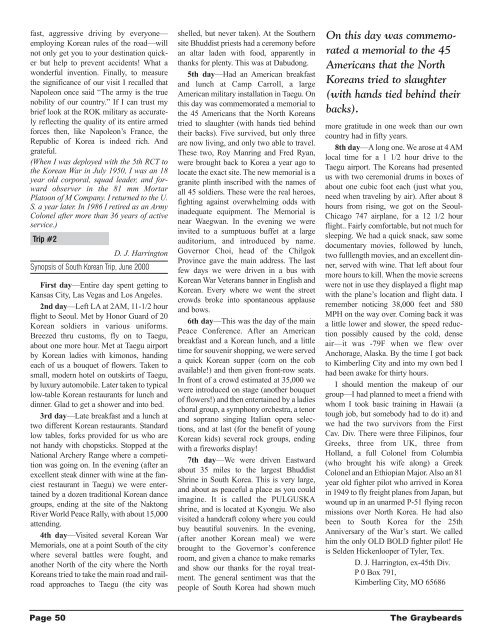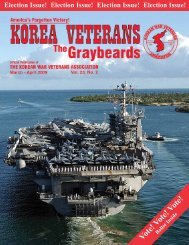The Graybeards - KWVA - Korean War Veterans Association
The Graybeards - KWVA - Korean War Veterans Association
The Graybeards - KWVA - Korean War Veterans Association
Create successful ePaper yourself
Turn your PDF publications into a flip-book with our unique Google optimized e-Paper software.
fast, aggressive driving by everyone—<br />
employing <strong>Korean</strong> rules of the road—will<br />
not only get you to your destination quicker<br />
but help to prevent accidents! What a<br />
wonderful invention. Finally, to measure<br />
the significance of our visit I recalled that<br />
Napoleon once said “<strong>The</strong> army is the true<br />
nobility of our country.” If I can trust my<br />
brief look at the ROK military as accurately<br />
reflecting the quality of its entire armed<br />
forces then, like Napoleon’s France, the<br />
Republic of Korea is indeed rich. And<br />
grateful.<br />
(When I was deployed with the 5th RCT to<br />
the <strong>Korean</strong> <strong>War</strong> in July 1950, I was an 18<br />
year old corporal, squad leader, and forward<br />
observer in the 81 mm Mortar<br />
Platoon of M Company. I returned to the U.<br />
S. a year later. In 1986 I retired as an Army<br />
Colonel after more than 36 years of active<br />
service.)<br />
Trip #2<br />
D. J. Harrington<br />
Synopsis of South <strong>Korean</strong> Trip, June 2000<br />
First day—Entire day spent getting to<br />
Kansas City, Las Vegas and Los Angeles.<br />
2nd day—Left LA at 2AM, 11-1/2 hour<br />
flight to Seoul. Met by Honor Guard of 20<br />
<strong>Korean</strong> soldiers in various uniforms.<br />
Breezed thru customs, fly on to Taegu,<br />
about one more hour. Met at Taegu airport<br />
by <strong>Korean</strong> ladies with kimonos, handing<br />
each of us a bouquet of flowers. Taken to<br />
small, modern hotel on outskirts of Taegu,<br />
by luxury automobile. Later taken to typical<br />
low-table <strong>Korean</strong> restaurants for lunch and<br />
dinner. Glad to get a shower and into bed.<br />
3rd day—Late breakfast and a lunch at<br />
two different <strong>Korean</strong> restaurants. Standard<br />
low tables, forks provided for us who are<br />
not handy with chopsticks. Stopped at the<br />
National Archery Range where a competition<br />
was going on. In the evening (after an<br />
excellent steak dinner with wine at the fanciest<br />
restaurant in Taegu) we were entertained<br />
by a dozen traditional <strong>Korean</strong> dance<br />
groups, ending at the site of the Naktong<br />
River World Peace Rally, with about 15,000<br />
attending.<br />
4th day—Visited several <strong>Korean</strong> <strong>War</strong><br />
Memorials, one at a point South of the city<br />
where several battles were fought, and<br />
another North of the city where the North<br />
<strong>Korean</strong>s tried to take the main road and railroad<br />
approaches to Taegu (the city was<br />
shelled, but never taken). At the Southern<br />
site Bhuddist priests had a ceremony before<br />
an altar laden with food, apparently in<br />
thanks for plenty. This was at Dabudong.<br />
5th day—Had an American breakfast<br />
and lunch at Camp Carroll, a large<br />
American military installation in Taegu. On<br />
this day was commemorated a memorial to<br />
the 45 Americans that the North <strong>Korean</strong>s<br />
tried to slaughter (with hands tied behind<br />
their backs). Five survived, but only three<br />
are now living, and only two able to travel.<br />
<strong>The</strong>se two, Roy Manring and Fred Ryan,<br />
were brought back to Korea a year ago to<br />
locate the exact site. <strong>The</strong> new memorial is a<br />
granite plinth inscribed with the names of<br />
all 45 soldiers. <strong>The</strong>se were the real heroes,<br />
fighting against overwhelming odds with<br />
inadequate equipment. <strong>The</strong> Memorial is<br />
near Waegwan. In the evening we were<br />
invited to a sumptuous buffet at a large<br />
auditorium, and introduced by name.<br />
Governor Choi, head of the Chilgok<br />
Province gave the main address. <strong>The</strong> last<br />
few days we were driven in a bus with<br />
<strong>Korean</strong> <strong>War</strong> <strong>Veterans</strong> banner in English and<br />
<strong>Korean</strong>. Every where we went the street<br />
crowds broke into spontaneous applause<br />
and bows.<br />
6th day—This was the day of the main<br />
Peace Conference. After an American<br />
breakfast and a <strong>Korean</strong> lunch, and a little<br />
time for souvenir shopping, we were served<br />
a quick <strong>Korean</strong> supper (corn on the cob<br />
available!) and then given front-row seats.<br />
In front of a crowd estimated at 35,000 we<br />
were introduced on stage (another bouquet<br />
of flowers!) and then entertained by a ladies<br />
choral group, a symphony orchestra, a tenor<br />
and soprano singing Italian opera selections,<br />
and at last (for the benefit of young<br />
<strong>Korean</strong> kids) several rock groups, ending<br />
with a fireworks display!<br />
7th day—We were driven Eastward<br />
about 35 miles to the largest Bhuddist<br />
Shrine in South Korea. This is very large,<br />
and about as peaceful a place as you could<br />
imagine. It is called the PULGUSKA<br />
shrine, and is located at Kyongju. We also<br />
visited a handcraft colony where you could<br />
buy beautiful souvenirs. In the evening,<br />
(after another <strong>Korean</strong> meal) we were<br />
brought to the Governor’s conference<br />
room, and given a chance to make remarks<br />
and show our thanks for the royal treatment.<br />
<strong>The</strong> general sentiment was that the<br />
people of South Korea had shown much<br />
On this day was commemorated<br />
a memorial to the 45<br />
Americans that the North<br />
<strong>Korean</strong>s tried to slaughter<br />
(with hands tied behind their<br />
backs).<br />
more gratitude in one week than our own<br />
country had in fifty years.<br />
8th day—A long one. We arose at 4 AM<br />
local time for a 1 1/2 hour drive to the<br />
Taegu airport. <strong>The</strong> <strong>Korean</strong>s had presented<br />
us with two ceremonial drums in boxes of<br />
about one cubic foot each (just what you,<br />
need when traveling by air). After about 8<br />
hours from rising, we got on the Seoul-<br />
Chicago 747 airplane, for a 12 1/2 hour<br />
flight.. Fairly comfortable, but not much for<br />
sleeping. We had a quick snack, saw some<br />
documentary movies, followed by lunch,<br />
two fulllength movies, and an excellent dinner,<br />
served with wine. That left about four<br />
more hours to kill. When the movie screens<br />
were not in use they displayed a flight map<br />
with the plane’s location and flight data. I<br />
remember noticing 38,000 feet and 580<br />
MPH on the way over. Coming back it was<br />
a little lower and slower, the speed reduction<br />
possibly caused by the cold, dense<br />
air—it was -79F when we flew over<br />
Anchorage, Alaska. By the time I got back<br />
to Kimberling City and into my own bed I<br />
had been awake for thirty hours.<br />
I should mention the makeup of our<br />
group—I had planned to meet a friend with<br />
whom I took basic training in Hawaii (a<br />
tough job, but somebody had to do it) and<br />
we had the two survivors from the First<br />
Cav. Div. <strong>The</strong>re were three Filipinos, four<br />
Greeks, three from UK, three from<br />
Holland, a full Colonel from Columbia<br />
(who brought his wife along) a Greek<br />
Colonel and an Ethiopian Major. Also an 81<br />
year old fighter pilot who arrived in Korea<br />
in 1949 to fly freight planes from Japan, but<br />
wound up in an unarmed P-51 flying recon<br />
missions over North Korea. He had also<br />
been to South Korea for the 25th<br />
Anniversary of the <strong>War</strong>’s start. We called<br />
him the only OLD BOLD fighter pilot! He<br />
is Selden Hickenlooper of Tyler, Tex.<br />
D. J. Harrington, ex-45th Div.<br />
P 0 Box 791,<br />
Kimberling City, MO 65686<br />
Page 50<br />
<strong>The</strong> <strong>Graybeards</strong>

















